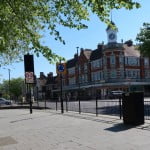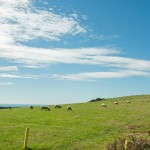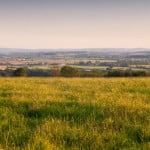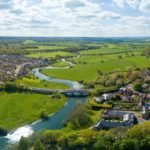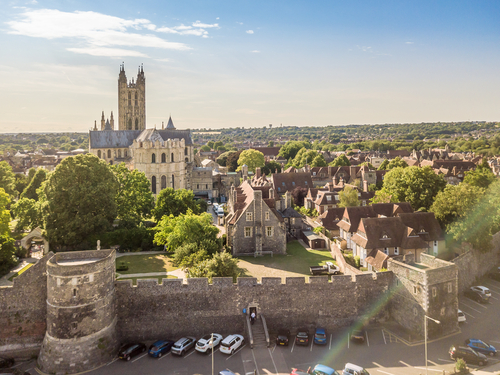
Canterbury is a historic city in the east of Kent and the southeast of England. It lies on the River Stour about 55 miles (89 km) south-east of London and 6 miles (10 km) south of Whitstable. Kent’s only city has been England’s primary ecclesiastical centre since the late 6th century. The cathedral and surrounding area are a UNESCO World Heritage Site which has helped make Canterbury one of the UK’s most visited places. In 2019, the best estimate of the city’s population was 63,697.
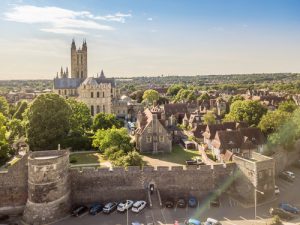
Image credit: Alexey Fedorenko/Shutterstock.com
A Bit Of Canterbury History
Early Days
There is archaeological evidence to suggest that the Canterbury area was first inhabited as early as the Stone Age. Canterbury itself started out as the Roman settlement of Durovernum Cantiacorum established in the first century following the Roman invasion of Britain in 43 AD. The name was derived from that of the Celtic Cantiaci (or Cantii) people who inhabited the area at that time.
The Roman withdrawal of Britain around 410 AD saw them quickly replaced in Canterbury by the Anglo-Saxon Jutes. The town became the main settlement of the Jutish kingdom of Kent and was renamed Cantwaraburh, translating as “Kent people’s stronghold”.
In 597 AD, Pope Gregory sent the monk Augustine to Kent to convert its Anglo-Saxon peoples to Christianity. The missionary was warmly welcomed by the Saxon King, Æthelbert, since his wife Queen Bertha, a Frankish (West European) princess, was already a committed Christian. Augustine went on to found the town’s cathedral and establish Canterbury as the first English hub of Christianity.
He was duly appointed as the first Archbishop of Canterbury, a position that still heads up the English church. He was buried in 604 AD at the abbey named in his honour ‘St Augustine’s. He was canonised by the church soon after death.
Middle Aged Canterbury
Between 835 and 855, Kent was particularly prone to attacks by Danish Viking raiders. Canterbury’s ecclesiastical status had seen it grow wealthy, and thus, it became much targeted by the marauding Vikings. There most devastating raids took place in 842 and 851, with a further wave of persistent attacks occurring in the late 10th and early 11th centuries. In 1011, one raid saw the Danes demand that Archbishop Alphege surrender the cathedral’s valuables.
The city was under siege for 20 days before its townsfolk capitulated. Much of the cathedral and town was razed to the ground and saw the bishop and other dignitaries captured. The reported fate of many of the town’s estimated population of 8,000 was that they were either slaughtered, held for ransom, or enslaved.
Here Comes The Normans
Following the Norman Conquest of 1066, the town’s Cathedral and Abbey were rebuilt in stone. William, the new king, also ordered the building of a timber motte-and-bailey castle for defence purposes. In the early 12th century the castle was rebuilt with stone.
In 1170, the infamous murder of Archbishop Thomas Becket took place at the cathedral. The incident catapulted Canterbury to notoriety throughout Europe. When Becket was canonised shortly afterwards, it saw pilgrims from all parts of Christendom head to Canterbury to visit his shrine. These pilgrimages provided the basis for a collection of stories that made up Geoffrey Chaucer’s famed 14th-century publication, ‘The Canterbury Tales‘.
In 1348, Canterbury suffered serious devastation when an outbreak of plague hit the town. It’s thought that this particular bout of the Black Death killed around half of Canterbury’s population of 10,000. The 14th century also saw the murder of another Archbishop of Canterbury, Simon Sudbury. As well as the serving head of the church, he was also the Lord Chancellor of England. He met a violent death during the Peasants’ Revolt while on an errand to the Tower of London.
On 14 June 1381, the highly unpopular Sudbury was seized by an angry Kentish mob who had ascended on the capital. He was dragged to Tower Hill, where he was unceremoniously beheaded.
In 1413, Henry IV was buried at Canterbury cathedral and remains the only Monarch to be interred there. In 1448, Canterbury was granted a ‘city charter’, entitling it to elect a mayor and high sheriff.
The Tudor & Stuart Period
In 1504, building work on the cathedral came to an end after four centuries, when the Bell Harry Tower was finally completed. However, the bad news was on the way for the Catholic church and cathedral. In 1536, King Henry VIII’s Dissolution of the Monasteries Act saw the English church split from Rome. The subsequent creation of the Church of England saw vandalisation and looting of the old church’s assets. Canterbury is the country’s main centre of the Catholic church suffered devastation.
At least half a dozen of the city’s major religious buildings were destroyed. St Augustine’s Abbey was turned over to the Crown and its buildings slowly dismantled over the next 15 years. The cathedral’s shrine to Thomas Becket was destroyed and all its treasures moved to the Tower of London. Any evidence of Becket’s existence was removed throughout the entire country.
By the start of the 17th century, Canterbury’s population stood at around 5,000. It’s estimated that some 40% of those were French-speaking Protestant Huguenots. They had been fleeing religious persecution in the Low Countries (present-day Belgium and the Netherlands) for the previous 50 years. Many were expert silk weavers, a skill they introduced to Canterbury’s dwellers. By the 1670s, the production of silk had outstripped wool weaving as the city’s main industry.
The Civil War
From the beginning of the English Civil War in 1642, Canterbury like much of Kent had largely settled for Parliamentary control. However, when the authorities tried to quash the Christmas celebrations of 1647, sentiments in Kent quickly turned firmly against Cromwell’s rule. Kentish Royalists took advantage of local anti-government feelings and managed to secure a number of Kent’s key towns, including Canterbury.
Some five months later, this event led to the highly significant ‘Battle of Maidstone’, which kicked-off what was termed the ‘Second English Civil War’. However, when the Parliamentarians secured victory at Maidstone, Canterbury surrendered peacefully to government control.
However, Canterbury would be witness to the return of the monarchy in little over a decade. In May 1660, King Charles II stopped overnight in Canterbury on his return from exile in France. He was making his way to London after landing at Dover on the 23rd of May. He later attended a service at Canterbury Cathedral to celebrate the restoration of the English monarchy.
Georgian & Victorian Times
In 1717, the city saw the publication of its first newspaper, the Kentish Post and later (in 1786), it merged with the newly founded Kentish Gazette set up by local businessman James Simmons. In 1787, an Act of Parliament was passed to form a Pavement Commission that was responsible for the paving, cleaning and lighting of Canterbury’s streets. The same year saw most of the gates of the old city wall being demolished to accommodate road widening for the ever-increasing number of coaches.
In the 1790s, Mayor Simmons gifted the Dane John Gardens to the city. However, the end of the century saw the city’s once-thriving silk industry killed off by imports of a cheap substitute, Indian muslin cloth. In the new century, Canterbury’s economy became dependent on agriculture, especially hops and wheat.
The Worlds Third Oldest Railway
In 1830, the 7-mile Canterbury to Whitstable line opened, becoming only the third railway line in the world. However, by 1844, the company had gone bankrupt and the line was purchased by the South Eastern Railway (SER). By 1846, Canterbury was connected to SER’s national network. The London, Chatham & Dover Railway arrived in 1860 setting up as a rival to SER. In 1848, St Augustine’s Abbey was refurbished for use as a missionary college for Church of England students from the British colonies.
In 1868, the Sidney Cooper School of Art opened, which would later become known as Canterbury College of Art. The Industrial Revolution which had brought major change and rapid growth to many of Britain’s town and cities had largely by-passed Canterbury. Between 1830 and 1900, the city’s population only grew from around 15,000 to 24,000, representing a rise of well under 1% per year.
The War Years
Before the start of WWI, Canterbury was garrisoned by the Royal East Kent Regiment (The Buffs). After their mobilisation in August 1914, the West Kent Yeomanry, Territorials and Kent Cyclist Battalion were all posted to Canterbury as part of the home defence strategy.
In the first 2 years of WW2, Canterbury saw little action. However, on 31 May and 1 June 1942, the city was the target as part of the Baedeker Blitz by the Luftwaffe. The targeted bombing raid on the country’s most historic towns and cities saw thousands of incendiary devices dropped on Canterbury. The two-day bombing resulted in 115 people being killed and a further 380 injured. Some 800 properties were also completely destroyed, with more than 1,000 others being seriously damaged, including the Cathedral’s library.
Canterbury is twinned with Reims in France.
The Modern Era
A major blow for the city came in 1953 when the Canterbury and Whitstable railway closed. On the positive side, the rebuilding of the Cathedral library was completed in the following year. Other events that helped shape the city were the opening of the University of Kent and Christ Church College during the 1960s. In the 1980s, the city saw visits from both Pope John Paul II and Queen Elizabeth II. The annual Canterbury Festival also kicked-off in the 1980s. In the early 2000s, the Whitefriars Shopping Centre underwent major redevelopment.
Today, the Canterbury District has one of the largest economies in Kent. The three major sectors are tourism, higher education and retail. In 2019, the 7.8 million visitors to the area supported well over 10,000 jobs. Tourism was worth more than £520 million, which accounted for around 15% of the local economy.
The annual two-week Canterbury Festival, held each October is one of the biggest such events in south-east England. The arts festival can attract up to 70,000 visitors, and includes classical and popular music, contemporary dance, comedy, theatre, lectures, visual arts, etc. Venues for the event are spread across the city and include impressive locations such as the Cathedral and the Marlowe Theatre. Another noteworthy arts event is the Stour Music Festival. The 10-day event held in June is a celebration of ”early” music that incorporates opera, choral, chamber concerts and other recitals.
Getting to Canterbury
By Car
Getting here from most parts of the country by car is straightforward. Just head towards London and then take the M25 circular road. Turn off on to the A2, which leads to the M2. It’s about 44 miles to Canterbury from the M25.
By Coach
National Express run 3 coaches per day from London Victoria Coach Station to Canterbury. The 61-mile journey usually takes around 1 hour 20 minutes but can vary depending on your time of travel.
By Train
South Eastern trains operate regular services from London Victoria, St Pancras and Charing Cross to both Canterbury East and Canterbury West stations. The journey usually takes around 90 minutes but the fastest trains from St Pancras take less than an hour.
By Air
The nearest airport to Canterbury is Southend Airport, about 26 miles away, but it has a very limited flight schedule. London City Airport is about 47 miles and has flights to/from domestic and European destinations only. The nearest major international airport is London Stanstead which is around 56 miles away.
Did you know?
- The 7-mile Canterbury to Whitstable railway line, which opened in 1830, was dubbed ‘The Crab and Winkle Line’, due to Whitstable’s reputation as a seafood haven.
- In 1834, the Canterbury & Whitstable Railway Company began operating the world’s first scheduled train passenger service.
- There is no evidence to suggest that the famed 14th-century author of ‘The Canterbury Tales’, Geoffrey Chaucer, ever visited the city.
- It was granted a city charter in 1448.
- Mary Tourtel (see below) of Rupert the Bear fame, spent much of her adult life here moving from hotel to hotel. She never had a fixed home, citing that she enjoyed the ‘freedom’ that her lifestyle provided.
Notable People Associated With Canterbury
Some of the notable people have links to the city including:
Religious leaders
- St Augustine (circa 530 – 604) – was also known as ‘Augustine of Canterbury’, was a Benedictine monk. He was chosen by Pope Gregory the Great to lead a Christian missionary to Britain in 595 AD. Considered the founder of the English Church, he was declared the first Archbishop of Canterbury in 597 AD.
- Thomas Becket (circa 1119 – 1170) – sometimes known as Saint Thomas of Canterbury, and later as Thomas à Becket, was Archbishop of Canterbury between 1162 and 1170. After a fall out with Henry II, King of England, he was famously murdered by the king’s supporters inside Canterbury Cathedral. He was canonised by Pope Alexander III soon after his death in 1170. He is revered as a saint and martyr by both the Anglican and Catholic Church.
Artists & Writers
- Christopher Marlowe (1564 – 1593) – achieved fame and notoriety as an Elizabethan poet and playwright. He was born circa 20 February 1564 in Canterbury, just 2 months before his contemporary, William Shakespeare, on whom many believe he was a great influence. He died in a bar-room brawl on 30 May 1593, allegedly over a bill. An outspoken and controversial figure, recent evidence suggests his death may well have been an assassination.
- Thomas Sidney Cooper (1803 – 1902) – was a renowned 19th-century landscape artist particularly noted for his depiction of farm animals. Copper’s career made him wealthy, and subsequently, he became a committed philanthropist. He was appointed a Commander of the Royal Victorian Order (CVO) by Edward VII in July 1901. Cooper was born in St Peter’s Street, Canterbury on 26 September 1803.
- Mary Tourtel ( 1874 – 1948) – was a writer and artist, who created the famed comic strip character ‘Rupert Bear’. The loveable ‘bear’ stories went on to achieve multi-million sales worldwide. Born Mary Caldwell on 28 January in Canterbury, she studied under Thomas Sidney Cooper at his Canterbury Art School. Mary died in Canterbury on 15 March 1948.
More Recent
- Sir Frederick Alfred Laker (1922 – 2006) – was an airline entrepreneur, best known for founding Laker Airways in 1966. Known as universally ‘Freddie’, he is generally credited with introducing the budget airline model to the world. Freddie was born in Canterbury on 6 August 1922 and went on to attended the Simon Langton Grammar School. Later, he began his aviation career with Short Brothers in Rochester.
- Orlando Bloom – is an internationally renowned actor who was born in Canterbury on 13 January 1977. He began his acting career on British TV in the mid-1990s. He is arguably best known for his roles in the highly popular film series’: The Lord of the Rings, The Hobbit and Pirates of the Caribbean. He last starred in The Outpost made in 2020.
Sport In Canterbury
Kent County Cricket Club
St Lawrence’s ground is home to Kent County Cricket Club. They play their cricket in the first-class County Championship. The 7.000 capacity ground is also used for international and world cup cricket.
Canterbury City FC
Canterbury City currently (2021) play their football in the Southern Counties East League Premier Division. Nicknamed ‘City’, they play home games at Salters Lane in Faversham, a 2,000 capacity ground.
Canterbury RFC
Canterbury RFC currently (2021) play in the 4th tier of English club rugby in National League 2. They play home games at the Marine Travel Ground, Merton Lane, which has a capacity of 1,500.
Canterbury Hockey Club
The Hockey Clubs men’s and ladies’ first teams play in their respective national hockey leagues. The club fields up to fifteen senior sides and various youth teams on a regular basis. The club plays home games at Polo Park.
Things to see in Canterbury
Canterbury is one of the most visited places in the UK which is no surprise given its ecclesiastical significance and its long and often violent history. Anyway here are a few must-visit places:
Canterbury Cathedral – is one of the world’s most famous places of worship. The seat of the Archbishop of Canterbury, it’s recognised as the Mother Church of the global Anglican Community. Since its founding by St Augustine’s in 597 AD, the church has been rebuilt by both the Saxons and the Normans.
Some of the 12th-century building still exists though many parts have been added and demolished over the centuries. Its large medieval stained glass windows are recognised as some of the best such examples in the world.
St Augustine’s Abbey – is the ruin of a Benedictine monastery that was founded in 598 AD. It operated as a monastery until its dissolution in 1538 during the English Reformation. The abbey was then gradually dismantled over the next 3 centuries. What was left of the abbey has been preserved, along with a number of outbuildings and prestigious graves.
The Church of St Martin – is an ancient parish church dating from circa 580 AD. It is considered to be the first church founded in England and have the longest continuous history in serving as a parish church throughout the English-speaking world. St Martin’s, along with the Cathedral and St Augustine’s Abbey, forms Canterbury’s UNESCO World Heritage Site.
Other Historic Attractions
Westgate – is the only remaining one of the seven Medieval city gates that once defended the city. The imposing 60 ft (18 m) high, 14th-century gate tower still has a drawbridge, portcullis, and ancient wooden doors. The tower museum notably houses plaster casts used for the bronze sculptures that adorn the House of Lords and Westminster. The figures represent the 18 signatories to the Magna Carta.
Canterbury Tales – is a city centre museum dedicated to the life of the author and poet Geoffrey Chaucer. Chaucer’s famed ‘The Canterbury Tales’ are brought to life through a virtual interactive 14th-century pilgrimage from London to Canterbury. A gift shop is also present at the site.
Eastbridge Hospital – is officially known as the Hospital of St. Thomas the Martyr. The well-preserved building was established in the late 12th century as a place of hospitality for visiting pilgrims paying homage to Thomas Becket. The Franciscan Gardens and the 13th-century Greyfriars Chapel are also well worth a visit.
Beaney House of Art & Knowledge – is a centrally-located museum, library, and art gallery. It’s named after Canterbury-born expatriate James George Beaney, who bequeathed £10,000 to the city to set up the museum. Displays include Egyptian and Greek artefacts, local Anglo-Saxon finds, as well as anthropological and natural history exhibits.
Canterbury Roman Museum – has one of the UK’s only remaining in-situ Roman pavement mosaics. Uniquely, the museum has been built around the discovered remains of a Roman domus (townhouse) giving visitors an authentic feel to what life was like in Roman Britain. There are also collections of Roman pottery, glassware, jewellery, ornaments and silverware.
Things to do in Canterbury
Some of the top things to do are:
Marlowe Theatre – is named after Canterbury-born Elizabethan playwright, Christopher Marlowe, and is the city’s premier performing arts venue. Refurbished in 2011, the theatre runs a full and varied programme of concerts, drama, musicals, operas, ballet, dance shows, children’s shows and stand-up comedy.
Stour Boat Trip – is a 40-minute rowing boat trip along the River Stour. It aims to give a fresh perspective on some of Canterbury’s best-loved Medieval sights. Canterbury Historic River Tours operate the boat trip between March and October.
Howletts Animal Park – consists of 100 acres of historic parkland at Bekesbourne, about 6 miles from Canterbury. The private zoo is one of the most visited animal attractions in the UK. There are around 50 different species of animal, all housed in spacious paddocks and enclosures. If the animals are not enough, there’s also zip-wires and high ropes to keep kids amused.
Wildwood Trust – is a wildlife park set in 40 acres (16ha) of ancient woodland. The park is home to more than 200 native animals of past and present. These include bears, wolves, bison, deer, owls, foxes, red squirrels, wild boar, lynx, wild horses, badgers and beavers. The Trust is dedicated to protecting, conserving and rewilding Britain’s wildlife. There’s also educational trails, an adventure playground, a picnic area, a café and shop.
Where to stay?
Not surprisingly given its significance as a tourist destination there’s a good range of available accommodation available though it’s probably a little more expensive than the rest of the county. For group travel, holiday home-style accommodation generally offers good value. However, prices vary greatly, depending on standard and location. A broad price guide for an overnight stay in the city for 2 adults sharing is:
Inn/Guesthouse/Lodge/Small hotel: £70 – £120
Luxury Hotel: £120 – £200
Thinking of moving to Canterbury?
Who could blame you – its such a lovely place, however, the house prices tend to reflect this. Over the last 12 months, properties in the city have fetched an average price of £314,700 (Jan 2021). In the last year, the best-selling properties have been semi-detached houses, which have sold for an average price of £327,200. Flats averaged £172,400, while for terraced properties its £258,400. Detached properties are as expected the most expensive fetching around £473,000.
Thank you for joining us on our Five Minute Overview of the town which is probably Englands most religiously significant city. Before you go why not have a read of some of our other guides or try some of our growing range of quizzes. Also, why not join our growing community it’s free and could be very rewarding going forward.


